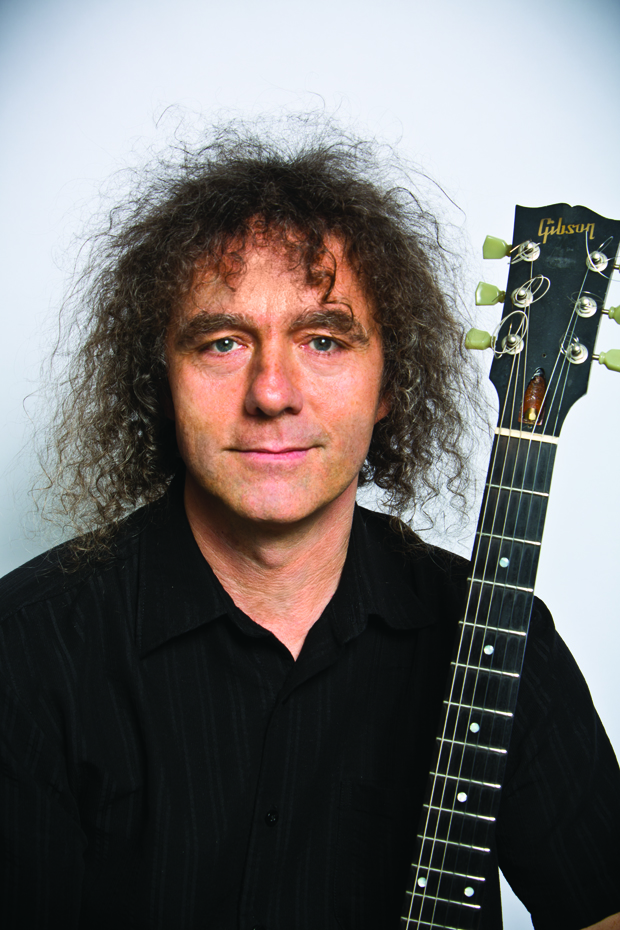String Theory with Jimmy Brown: A Pick-Friendly Way to Sound Like an Irish Folk Mandolinist

Using the same “mandolin trick” I introduced last month—deploying a capo high up on the neck to emulate the sound and feel of a mandolin—I’d like to present another cool-sounding, alternate-picking-friendly solo guitar interpretation of a popular bluegrass fiddle tune, this one being an arrangement of a traditional Irish reel called “Red Haired Boy” (also known as “The Red Headed Irishman” and “The Jolly Beggar”).
While most bluegrass standards are based on the major scale, this one is based on the Mixolydian mode, specifically A Mixolydian (A B Cs D E Fs G). The mode’s minor, or “flatted,” seventh, G natural, gives it a distinctly Celtic, old-world quality, which to me sounds kind of mystical and brings to mind the highlands of Ireland and Scotland.
Figure 1 shows how I play “Red Haired Boy,” using a capo at the 12th fret. I perform it on a solidbody electric guitar equipped with a piezo pickup, which produces an acoustic-guitar-like sound. All pick strokes and fret-hand fingerings are included to guide you. As with last month’s arrangement of “The Eighth of January,” you’ll need to lower the capo at least two frets if you’re going to play this arrangement on an acoustic guitar, due to that instrument’s much bulkier heel at the neck-body joint.
I’ve strategically arranged the note fingerings, as I did for “The Eighth of January,” so that every eighth-note string cross is performed with “outside-the-strings” picking to avoid the dreaded “inside-the-strings” picking, which is arduous and makes alternate picking a drag, both figuratively and literally! Specifically, notice that I use the open G, B and high E strings (relative to the capo) in certain spots and, elsewhere, the fifth- or fourth-fret equivalents of these notes on the next lower string (your “tuning notes”).
This kind of thoughtful fingering planning is the magic secret to drudgery-free alternate picking that, surprisingly, many guitarists never discover. For me, this pragmatic approach was born out of frustration and necessity, as I became fed up with trying to muscle my way through difficult string crosses. Why climb over a wall when you can easily go around it? Yet most bluegrass flatpickers will doggedly try to hurdle difficult string crosses and/or alternatively employ hammer-ons and pull-offs without considering the option of moving a note to a different string so that they can alternate pick the melody more easily.
I recently watched an online video interview with legendary bluegrass guitar master Tony Rice in which he revealed his approach to developing speed and dexterity. He explained that, while some players strive to master difficult picking moves through repetition at varying tempos, he prefers to play a tune at the desired performance tempo, which is usually faster than practice tempo. In doing so, he lets his hands and brain “figure out, through trial and error,” the best way to play something efficiently “in the heat of battle.”
Figure 2 presents a bluegrass-style second-guitar accompaniment pattern for “Red Haired Boy,” played as if the tune were in the key of G but with a capo at the second fret transposing everything up a whole step, to A, the key of the melody in Figure 1.
Get The Pick Newsletter
All the latest guitar news, interviews, lessons, reviews, deals and more, direct to your inbox!
When you listen to various performances of “Red Haired Boy” and other traditional bluegrass and old-timey tunes, you’ll notice that everybody seems to play them a little bit differently, but the tune is always recognizable, with its signature notes usually falling on the beats where the chords change.
Over the past 30 years, Jimmy Brown has built a reputation as one of the world's finest music educators, through his work as a transcriber and Senior Music Editor for Guitar World magazine and Lessons Editor for its sister publication, Guitar Player. In addition to these roles, Jimmy is also a busy working musician, performing regularly in the greater New York City area. Jimmy earned a Bachelor of Music degree in Jazz Studies and Performance and Music Management from William Paterson University in 1989. He is also an experienced private guitar teacher and an accomplished writer.
“It was tour, tour, tour. I had this moment where I was like, ‘What do I even want out of music?’”: Yvette Young’s fretboard wizardry was a wake-up call for modern guitar playing – but with her latest pivot, she’s making music to help emo kids go to sleep
“One of the guys said, ‘Joni, there’s this weird bass player in Florida, you’d probably like him’”: How Joni Mitchell formed an unlikely partnership with Jaco Pastorius








![John Mayer and Bob Weir [left] of Dead & Company photographed against a grey background. Mayer wears a blue overshirt and has his signature Silver Sky on his shoulder. Weir wears grey and a bolo tie.](https://cdn.mos.cms.futurecdn.net/C6niSAybzVCHoYcpJ8ZZgE.jpg)

![A black-and-white action shot of Sergeant Thunderhoof perform live: [from left] Mark Sayer, Dan Flitcroft, Jim Camp and Josh Gallop](https://cdn.mos.cms.futurecdn.net/am3UhJbsxAE239XRRZ8zC8.jpg)
